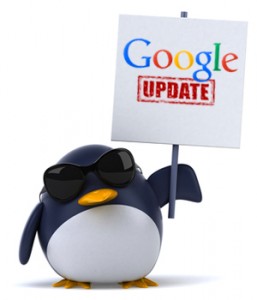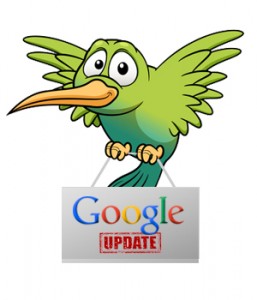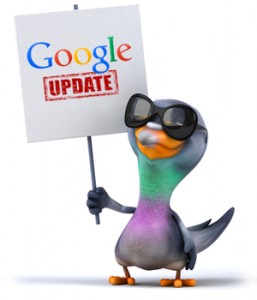Google Update - Small | Weboptim
Google has so far introduced 4 major algorithm updates: the Panda, Penguin, Hummingbird and Pigeon. In addition to these there have of course been minor updates, but they have had little or no impact on organic search results.
It now has more than 200 ranking factors. But which ones should we pay more attention to after each algorithm update?
Overview
What are Google algorithms?
The word algorithm refers to a step-by-step process based on logical relationships to solve a problem. In online marketing, this problem is how to make your website the most relevant for a given search term. In short, it is what Google searches for, ranks and finds relevant.

Google's core purpose is to provide the most relevant search results for users. The algorithms are also designed to do this - but the changes have resulted in (often dramatic) penalties for many websites. Mobile results are also affected - experts say the recent updates will have a significant impact on mobile users.
What are the SEO benefits of algorithm changes?
Overall, Panda, Penguin, Hummingbird and Pigeon also had a (positive) impact on search engine optimisation:
- increase user-centred engagement - as we've said before, Google's goal is to help users find the information they're looking for as quickly and efficiently as possible. This is the particular focus of Panda.
- deeper content for better ranking - longer content can rank better in searches. Again, Panda is worth mentioning here: low content is less effective, with articles of around 300 words. Google's view is that more in-depth content is also likely to be more useful.
- benefits of fresh content - when we publish content, Google gives the website a score. Over time, this number decreases, but if you keep adding fresh posts, you can expect improved rankings and increased traffic. Of course, you don't have to post new ones every day, even popular sites only post 1 to 1 new article a week on their website.
- brand awareness - not obvious, but algorithm changes are driving website owners towards brand building. Experts say that ideally, at least 20-30% of link texts are now brand/branded.
Let's go into the details of Google algorithms:
1. Google Panda algorithm
The Google Panda update has revolutionised search engine optimisation - those who may not have known it before have now learned that SEO is not permanent, it's constantly changing, and the best practices may be released tomorrow.
Panda was released in 2011. Basically a quality content can be described as a filter that focuses on weak or short pages and prevents them from ranking well in organic searches. After its release, individual site owners experienced a significant drop in website traffic. Overall, it changed content marketing, keyword research, link building. Since 2011, it has been updated every 1-2 months or so.

Key updates:
- Panda 1.0 - fight against linkfarms
- Panda 2.0 - examining international search results
- Panda 2.1-2.4 - taking into account more quality signals
- Panda 2.4 - focus on conversion rates and unique visitors
- Panda 3.0 - large sites have achieved better results
- Panda 4.0 - focuses on larger sites that achieve top rankings. Websites need valuable, interesting and problem-solving content. Sites such as ask.com and ebay.com were the main losers in the update.
What factors can lead to a penalty:
- duplicate content
- low quality inbound links - from irrelevant sites
- high return rate - if high, it means the user did not find what they were looking for or found the page unusable. What is acceptable? It varies by industry, but ideally it should be below 50-60%.
- low number of returning visitors - if a user visits only once and then never again, it shows Google that our site is not relevant or usable.
- high proportion of template texts - it is not advantageous, for example, to place a paragraph on several subpages. For one or two paragraphs, of course, there is no big problem, but if you have a very high amount of this kind of content, rankings can drop.
- irrelevant meta settings
2. Google Penguin algorithm
The first version was released in April 2012. While the Panda focused on content, the Penguin focused on focus on inbound links. The old link building technique is a thing of the past.

It penalises the following:
- link systems - refers to the activities we undertake to generate links to improve rankings.
- keyword stuffing - no matter how deep the content and how easy it is to navigate the site, excessive keyword voting will be found and punished by Penguin.
- over-optimization - keyword and link text analysis.
- unnatural links - links that are completely off-topic. Not good for users and not good for Google.
What is the relationship between Panda and Penguin?
If you are careful not to create short and low quality content, you can get links naturally. This is the link between the two.
3. Hummingbird algorithm
In 2013, one of the most significant improvements to the algorithm was released. Hummingbird provides Google with a fast and accurate platform where users can easily find what they are looking for, not only when searching for a specific keyword, but also for similar terms (long-tail words).
A focus on users, not keywords. You need content that solves the problem.

Main element of the "dialogue searchs" : for example, we are not looking for 'there-lending', but that 'what to look out for before renting a car'. It is important to know how people talk/search for information.
4. Google Dove algorithm
It was introduced in July 2014. When searching, you will often notice that the web search results, and the Google Maps results are very different from each other. The update tries to bring the results of these two lists closer together, i.e. to match the map results with the standard web results.

So it mainly affects Google Maps results:
- It rewards sites that use a familiar term for a local context or a colloquial term for the same context. Let's take an example: a stranger visits a new neighbourhood, which he names Garden City, as the map tells him. But the people who live there have never heard that name, they call the neighbourhood Ságod. So there are 2 names, one place, but which is the right one? With the algorithm update, both.
- It ensures that local results are displayed alongside those that are nearby.
- It gives more weight to local businesses that use keywords that include specific location.
Getting around
Focus on creating good content that generates natural links. This is the easiest way to increase traffic to your site without getting penalised by Google.
Source: neilpatel.com